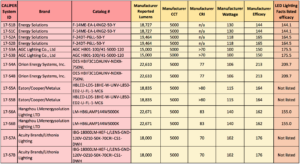The U.S. Department of Energy (DOE) LED Lighting Facts database has been a resource for identifying high-performing light-emitting diode (LED) luminaires since 2010. Receiving data on more than 70,000 products to date, it has been a way for the DOE to assess the progress of the solid state lighting industry and to help lighting specifiers find high-efficiency, high-quality luminaires. In 2017, several products were listed with claimed efficacies near or exceeding 200 lumens per watt (lm/W). The Top Efficacy Performers project was launched to procure samples of these luminaires for testing and visual evaluation.
Although there are luminaires exceeding 200 lm/W available on the market, there are many reasons why it is complicated to order products that perform at that level.
- The LED Lighting Facts database allows manufacturers to list families of luminaires under the performance characteristics of the top-performing product in the family. Consequently, many luminaires having different lumen output, different color and optical characteristics, and different sizes and drivers are listed under the same values as the top-performing product.The luminaire corresponding to a catalog number in the LED Lighting Facts database is often difficult to track down and order, so often it is not clear that the ordered product should have the same features and performance listed in the database.
- Ultimately, samples of seven luminaires were anonymously ordered for this Top Efficacy Performers Study, five from the LED Lighting Facts database and two unlisted high-efficacy products found through a website search. All products were 5000K, and all but one had LED packages that were directly visible, either open to the air or behind clear plastic or glass covers. They underwent CALiPER photometric testing at PacificNorthwest National Laboratory’s (PNNL’s) Lighting Metrology Laboratory in Richland, WA, and the resulting values were compared to the manufacturer-claimed values as published on website specification sheets. (Note, this is not necessarily the same as performance values as listed on the LED Lighting Facts database.)

Two of each luminaire type were shipped to PNNL’s Portland, OR, lighting laboratory and mounted in a movable ceiling. The luminaire pairs were spaced 14’ on center, 11’-3” above the floor, each pair controlled bya single wall switch. (Figure ES.1) [The installation ceiling height was intended to be 15’, but mechanicallimitations interfered with achieving the full mounting height, and that could have affected glare responses.] In situ measurements of horizontal illuminance, flicker, and maximum luminance were collected.
Twenty-three observers with experience in lighting and energy efficiency were recruited from local organizations and asked to evaluate the industrial luminaires, one pair at a time. Through a questionnaire, the observers provided comments and an overall perceived dollar value for the luminaire.
Results of laboratory testing showed the following maximum differences in performance compared to the manufacturer claimed values on website product specification sheets:
- 9.6% in lumen output
- 6.8% in power draw
- 12.0% in efficacy
- Color performance in correlated color temperature and color rendering index consistent with claimed values
Field measurements taken while the luminaires were mounted for visual evaluation showed that one of the seven luminaire types exhibited flicker exceeding the low-risk criteria of the IEEE Standard PAR1789-2015. All of the luminaires produced a fairly even light distribution across the workplane, with a maximum-to-minimum illuminance ratio below 1.7 at a 37” standing desk height. And, direct luminance measurements ofthe exposed LED packages revealed luminances ranging from 154,000 cd/m2 up to 478,000 cd/m2, although due to limitations in measurement, these values likely underestimate the actual luminances. One luminaire used diffusing tubes to cover the LED packages, with a luminance of 40,000 cd/m2. (By comparison, a T5HO fluorescent lamp is about 25,000 cd/m2 in luminance.) The high maximum luminances are likely to be the reason why glare was the biggest complaint from the observers.
The subjective evaluations showed that only two of the luminaires received reasonable ratings of visual comfort and overall quality, and those were the products with either diffusing lenses or reflector optics engineered to cut off the view of the bare LEDs above a fixed viewing angle. The top-rated three luminaires received positive comments in categories of light distribution, shadows, and color in addition to visual comfort. The least preferred luminaires correspond to the three luminaires receiving the most negative comments about glare. These rankings were corroborated by the overall dollar value observers assigned to each luminaire. The product receiving the highest rating was the luminaire with the lowest tested efficacy of 136 lm/W, showing that visual comfort needs to be considered in conjunction with efficacy because there are always tradeoffs in selecting the best luminaire for an application.
Luminaire efficacy is only one aspect of performance that should considered in a specification. Other attributes of performance such as visual comfort, light distribution, flicker, shadows, and color quality may end up being of equal or greater importance to the installation. However, this report demonstrates that there are truly LED products performing at very high levels of efficacy. The LED Lighting Facts and similar databases can be excellent sources of information for identifying high-performance LED products.
Researchers did point out the Lighting Facts Program run by the DoE ended in June, 2018. D+R International has taken over the program.
You can read a full report on the study here.